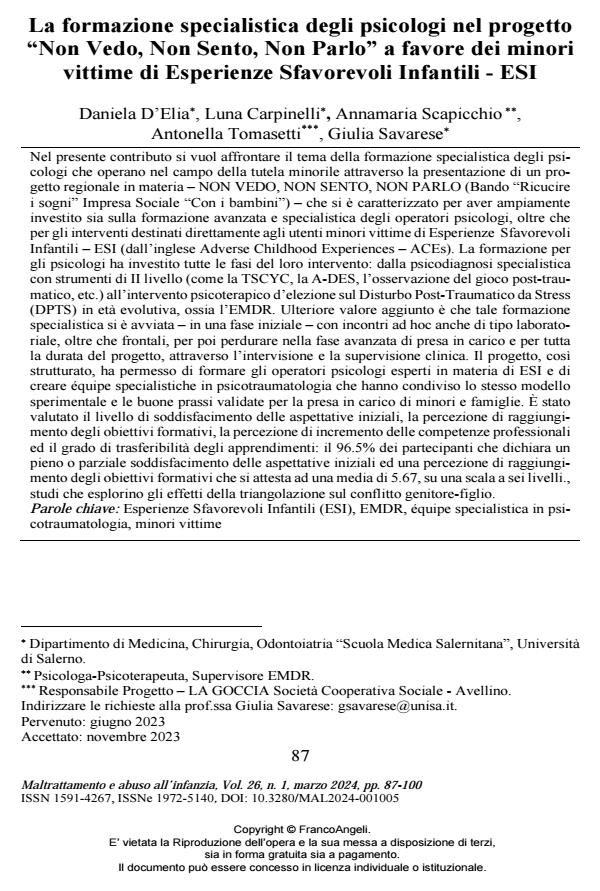The specialized training of psychologists in the project “I do not see, I do not hear, I do not speak” in favor of minor victims of Adverse Childhood Experiences – ACEs
Journal title MALTRATTAMENTO E ABUSO ALL’INFANZIA
Author/s Daniela D’Elia, Luna Carpinelli, Annamaria Scapicchio, Antonella Tomasetti,, Giulia Savarese
Publishing Year 2024 Issue 2024/1
Language Italian Pages 14 P. 87-100 File size 205 KB
DOI 10.3280/MAL2024-001005
DOI is like a bar code for intellectual property: to have more infomation
click here
Below, you can see the article first page
If you want to buy this article in PDF format, you can do it, following the instructions to buy download credits

FrancoAngeli is member of Publishers International Linking Association, Inc (PILA), a not-for-profit association which run the CrossRef service enabling links to and from online scholarly content.
In this contribution, we want to address the issue of specialized training of psycholo-gists working in the field of child protection through the presentation of a regional project on the subject – I DON’T SEE, I DON’T HEAR, I DON’T SPEAK (call “Ricucire i sogni” Social Enterprise “With children”) – which is characterized by hav-ing widely invested in advanced and specialized training of psychologists, as well as for interventions aimed directly at child users who are victims of Adverse Childhood Experiences (ACEs). The training for psychologists has involved all phases of their intervention: from specialized psychodiagnosis with II level tools (such as TSCYC, A-DES, observation of post-traumatic play, etc.) to the psychotherapeutic intervention of choice on Post-Traumatic Stress Disorder (PTSD) in developmental age, the EMDR therapy. A further added value is that this specialized training started – in an initial phase – with ad hoc training meetings, including laboratory as well as frontal, and then persisted in the advanced phase of taking charge and for the entire duration of the project, through intervision and clinical supervision. The project, structured in this way, allowed to train psychologists experts in the field of ACEs and to create special-ized teams in psychotraumatology who shared the same experimental model and good practices validated for taking care of minors and families. The level of fulfillment of initial expectations, perceived achievement of training objectives, the perceived in-crease in professional skills, and the degree of transferability of learning were as-sessed, with 96.5% of participants reporting full or partial fulfillment of initial expec-tations and a perceived achievement of training objectives averaging 5.67 on a six-level scale.
Keywords: Adverse Childhood Experiences (ACEs), EMDR, Specialist team in psy-chotraumatology, child victims
Daniela D’Elia, Luna Carpinelli, Annamaria Scapicchio, Antonella Tomasetti,, Giulia Savarese, La formazione specialistica degli psicologi nel progetto "Non Vedo, Non Sento, Non Parlo" a favore dei minori vittime di Esperienze Sfavorevoli Infantili - ESI in "MALTRATTAMENTO E ABUSO ALL’INFANZIA" 1/2024, pp 87-100, DOI: 10.3280/MAL2024-001005